|
During my first year of teaching in a first grade classroom, I had an unforgettable experience. Two vivacious first grade girls had been struggling for months trying to learn how to read. Then one day in February, the light turned on in their minds. Things started clicking. They had been crawling at a snail's pace but suddenly they were soaring.
This was one of the reasons I decided to teach my children at home—I wanted to be the one who was there to experience each leap in understanding as it occurred. What is more exciting than watching your child learn to read?
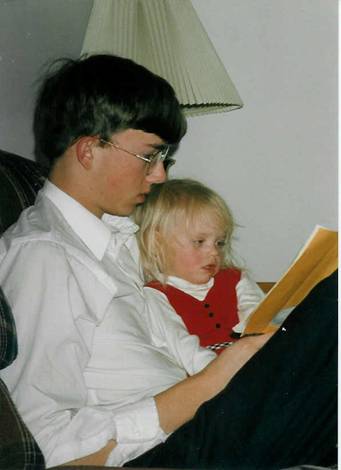 On the other hand, it may be intimidating to feel the responsibility of helping your child with this most important academic skill. From my three years as a first grade teacher, from the research I've done over the years, and from the opportunity to learn from our home school experiences over the past eleven years, I have some thoughts to share. On the other hand, it may be intimidating to feel the responsibility of helping your child with this most important academic skill. From my three years as a first grade teacher, from the research I've done over the years, and from the opportunity to learn from our home school experiences over the past eleven years, I have some thoughts to share.
A -- Read Aloud.
Reading aloud is one of the most essential and pleasurable ways of sharing the joy of reading. Experts agree that reading aloud is the most important activity we can do to prepare our children to read. We sit with our children crowded around us to read some favorite stories. In our family, we usually have a chapter book in progress for the older children. During other sessions, we read picture books for the younger children.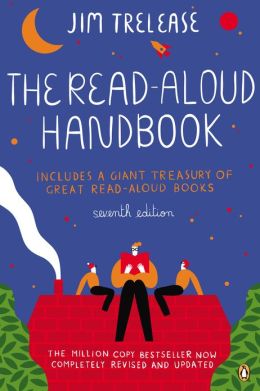
Don't make the mistake of thinking that once your children know how to read that you should stop reading aloud. I remember my elementary teachers reading aloud to the class everyday after lunch but it didn't profoundly affect me until my sixth grade teacher read
The Hobbit. I couldn't wait to come in from lunch recess to hear the next chapter. When Mrs. Colburn finished the novel, I reread it on my own. It launched me into reading more challenging material like The Three Musketeers. You never know which book will touch someone's life—or when.
 B -- Don't Rush Academics. B -- Don't Rush Academics.
Some parents seem to base their success on how early their child learns to read. After studying Elkind’s Miseducation: Preschoolers at Risk and books by Raymond and Dorothy Moore, I decided that a late start is often a better start. This has been confirmed several times by our own endeavors.
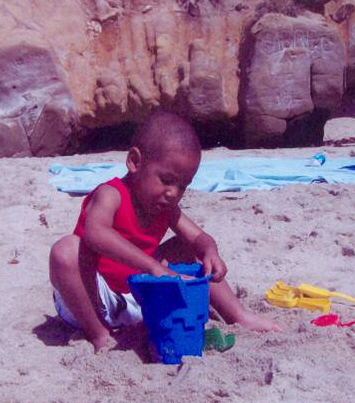 Ruth Beechick calls this the “optimum learning time.” She says if we wait until the child shows readiness and interest, the child will learn faster and easier. Many prominent people were late readers, so don't worry if your child is around eight or nine before he takes off. Ruth Beechick calls this the “optimum learning time.” She says if we wait until the child shows readiness and interest, the child will learn faster and easier. Many prominent people were late readers, so don't worry if your child is around eight or nine before he takes off.
Follow the child's lead; instead of pushing, let him come to you with questions or discoveries. At age two, my daughter was delighted with her magnetic letters. She'd spend hours at her little desk often asking me what a certain letter was. By age four, she knew most of the sounds, because of her own motivation, so I thought she would be an early reader. Surprisingly, things didn't “click” for her until she was almost eight. Even though she had the tools, she didn't have the maturity to master reading. There is more to reading than simply knowing phonetic sounds.
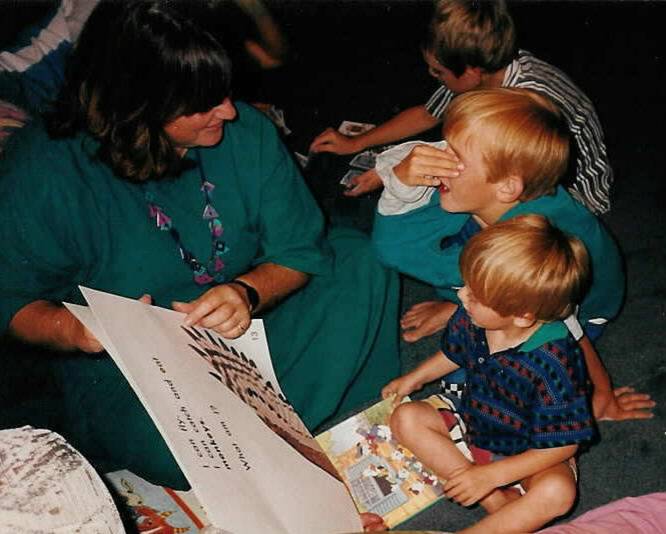 C -- Help Your Child Understand Print. C -- Help Your Child Understand Print.
At the end of the very first day of my second year of teaching first grade, a little girl came up to me nearly in tears. She looked at me and said, “But, Teacher, we can't go home yet. I haven't learned to read.” She tugged at my heartstrings so strongly that the next day I came prepared with predictable books and activities so that by the end of that second day of school every child would feel like he/she could read. The little girl was happy to go home the second day as a successful reader -- ready to show her parents what she had learned. Every child had a sense of accomplishment and success.
Predictable books are stories where the child can easily guess the text of the book because of a pattern, a rhyme, and/or the illustrations. Perhaps do an activity below once a week in the early stages of learning to read. Or simply enjoy reading predictable books together every day.
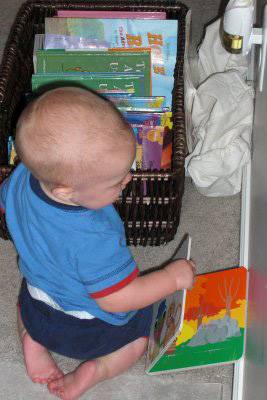 Print out songs and sing them, pointing to the words as you go. Write a familiar predictable story or nursery rhyme on a chart. Make three copies of it. Let your child become acquainted with the chart by reading it to him, reading it together, and allowing him to explore it on his own. Then help your child cut a copy of the chart into sentence strips. He can place the strips on the corresponding sentences on the chart. Or he can arrange them in order (or a silly order) without the chart. Later, help him cut the third chart into word cards. He can match the words onto the sentence strips or the story chart. Or he can make up original sentences from the word cards. These kinds of experiences help children realize that the whole is broken down into sentences, then into words, then into sounds. This is called global learning or learning from the top down; experts claim it is the way most children learn. Charlotte Mason, always ahead of her time, recommended a very similar approach for teaching reading. In volume one of her series, she wrote of using ‘Twinkle, Twinkle’ and ‘I Love Little Pussy’ and word cards for learning to read. Print out songs and sing them, pointing to the words as you go. Write a familiar predictable story or nursery rhyme on a chart. Make three copies of it. Let your child become acquainted with the chart by reading it to him, reading it together, and allowing him to explore it on his own. Then help your child cut a copy of the chart into sentence strips. He can place the strips on the corresponding sentences on the chart. Or he can arrange them in order (or a silly order) without the chart. Later, help him cut the third chart into word cards. He can match the words onto the sentence strips or the story chart. Or he can make up original sentences from the word cards. These kinds of experiences help children realize that the whole is broken down into sentences, then into words, then into sounds. This is called global learning or learning from the top down; experts claim it is the way most children learn. Charlotte Mason, always ahead of her time, recommended a very similar approach for teaching reading. In volume one of her series, she wrote of using ‘Twinkle, Twinkle’ and ‘I Love Little Pussy’ and word cards for learning to read.
Several times during the school year, I would post a large chart of a song we had learned together somewhere in the classroom. I wouldn't mention it but quietly watched as the students discovered the new addition. One of the better readers would usually figure it out first. Then even the non-readers would go to the chart, point to each word, and “read” it since they, too, knew the song. Children need successful experiences like this throughout the sometimes long and frustrating road to becoming an independent reader.
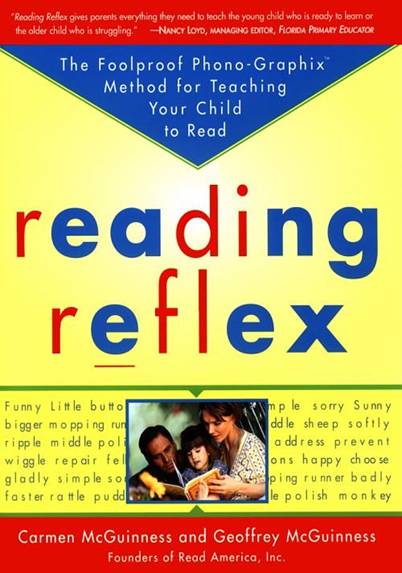 D -- Teach the Code. D -- Teach the Code.
You don't need to invest a large amount of money in a phonics program. All you need are homemade flashcards, pencil and paper, lower case magnetic letters, and an excellent book Reading Reflex by Carmen and Geoffrey McGuinness. (www.readamerica.net)
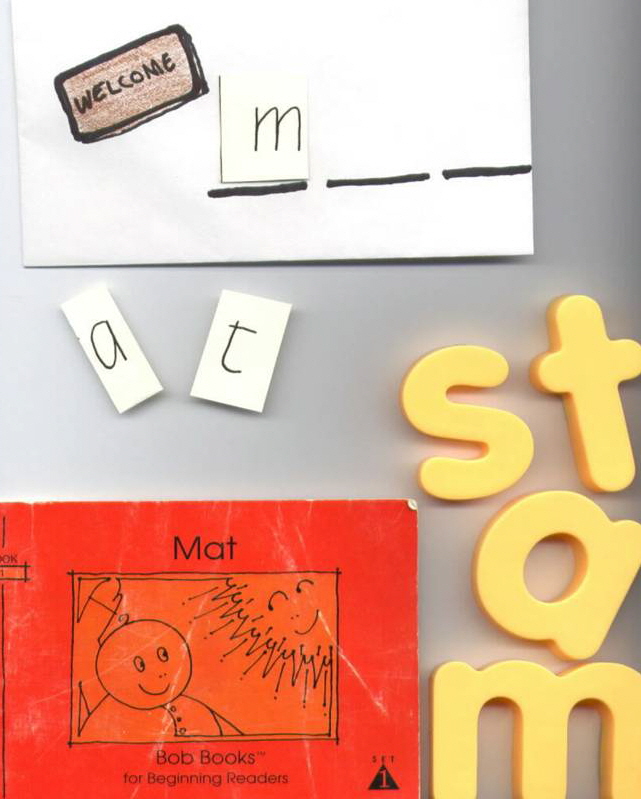 This is not your typical approach to phonics. The book starts by teaching the “basic code” or what I used to think of as simple phonics. Basic code is one symbol representing one sound, the most common sound. The authors state: “The first step in learning to read is understanding the nature of our written code. There are symbols that represent sounds. Each time we see one of the symbols, we are supposed to say the sound that it represents. We make our way through the word and when we get to the end we have meaning…” This is not your typical approach to phonics. The book starts by teaching the “basic code” or what I used to think of as simple phonics. Basic code is one symbol representing one sound, the most common sound. The authors state: “The first step in learning to read is understanding the nature of our written code. There are symbols that represent sounds. Each time we see one of the symbols, we are supposed to say the sound that it represents. We make our way through the word and when we get to the end we have meaning…”
“[This method] has been researched and proven to work on children age four to adult non-readers. It takes what the child knows, the sounds of his language, and teaches him the various sound pictures that represent those sounds.” By sound pictures or symbols, the authors are referring to the letter or combination of letters that represent a sound. 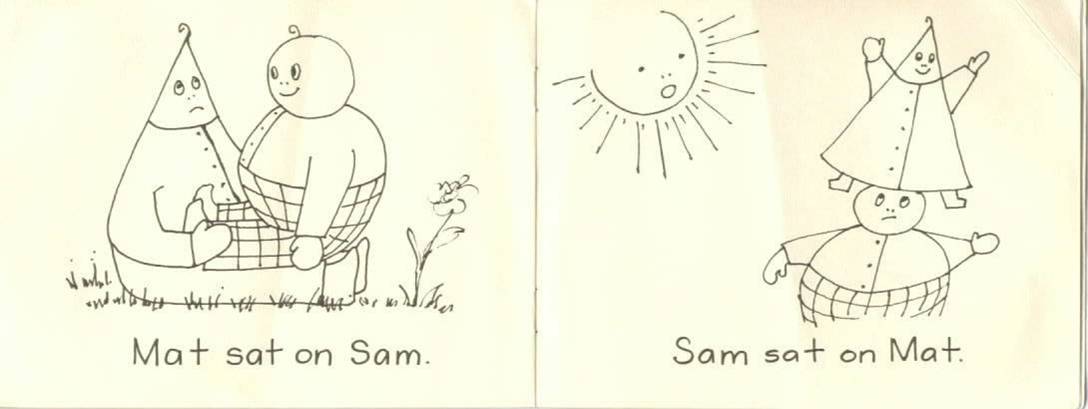
Have a few linguistic or easy phonetic readers available. I have adapted the order that sound pictures are presented in Reading Reflex to follow set one of the Bob Books by Scholastic. Play with your set of “Silly Sentences” for more practice.
|
You are welcome to use the reading program that I've developed. Build words and sentences using the PDFs that are available from me for free. Spelling words that correlate to the program are listed at spellingcity.com, a free website. Search for Penny Gardner to find my lists. Scroll down the list of spelling lists to Set 1. My lists start with sight words from the Fry list; the rest of the words follow the phonetic focus of that Set.
|
E -- Sight Words.
When a child is learning the basic code, there are common words that don't follow what he has learned so far. A few of these irregular words can be taught as sight words when they occur in the Bob Books or other easy phonetic readers. Some sight words are more phonetic than others so have the student look for clues. Start with these words: and, has, is, a, the, with, was, to, have, said. “And” is the easiest word in this list and is met in the adjacent consonant section of Reading Reflex. The other words are covered in the advanced code but they are so common that your beginning reader may need to learn them earlier.
Charlotte Mason stressed the importance of habits. If a child spells a word wrong, it may become a habit. Hindsight has shown me that invented spelling is not the best approach with these irregular words. Be thorough by teaching your child to spell each of these “weird words” and reviewing them often as they come up in his writing.
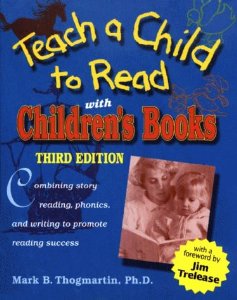 F – Fluency. F – Fluency.
Rereading familiar books, nursery rhymes, and charts with songs or poems will help the child gain fluency and mastery of reading. Mark Thogmartin, author of Teach a Child to Read with Children's Books, suggests starting each reading instruction session by having the child reread a book you have already worked on. Having time to read on his own, as mentioned above, will help the child gain fluency.
Echo reading is wonderful for fluency. I like to do this on material that is slightly above the child's comfortable reading level. Use children's literature that is not predictable for echo reading. Sit close together so you can both follow along in the book. The parent points to each word as parent and child read aloud together, pausing very slightly after each phrase. Sometimes the parent will read a split second after the child, echoing him on the easier parts. Sometimes the parent will take the lead so the child is echoing the parent through the difficult parts. Echo reading helps greatly with fluency and expressive reading.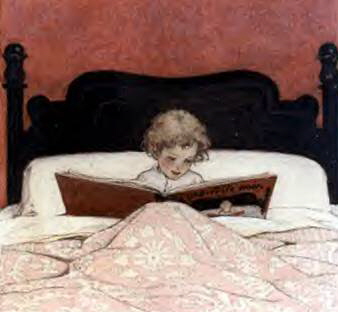
G – Give Your Child Time to Read on His Own.
John Holt wrote that children need time to figure things out for themselves. Many children have taught themselves how to read because they have been allowed this time. You might try to work in a quiet time after lunch when children may look at books, read, or nap. You might also allow a half-hour or hour of individual reading in bed at night. Perhaps your kids will read the familiar predictable books, nursery rhymes, or songs that you've been enjoying together during these quiet reading times. Once reading is mastered and the student is an independent reader, silent-reading sessions can become your “reading program.” Parents should model reading during these and other times.
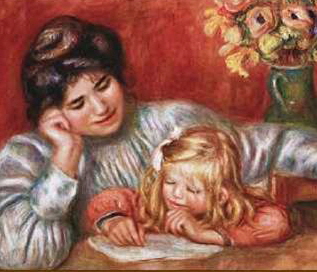 H – Home: A Writing-Rich Environment. H – Home: A Writing-Rich Environment.
Write stories or experiences down for the young child as he dictates to you; soon he will start doing the writing with your guidance. This could be a very short narration or a caption for the child's illustration. Thogmartin suggests that the child write a one or two sentence story each day as part of the reading lesson. He gives several good suggestions on helping the child to discover strategies for writing unknown words. For example, if the child has already learned to spell the word “my,” help the child realize that he can easily spell the unknown word “by.”
My children have all enjoyed writing before they learn to read. They ask how to spell certain words to make their own notes or they write a list of all the names of people in our family and extended family. Let children see you writing. Try having written conversations with your children. An early attempt might just require yes and no answers from the child. This may evolve into daily letter writing between 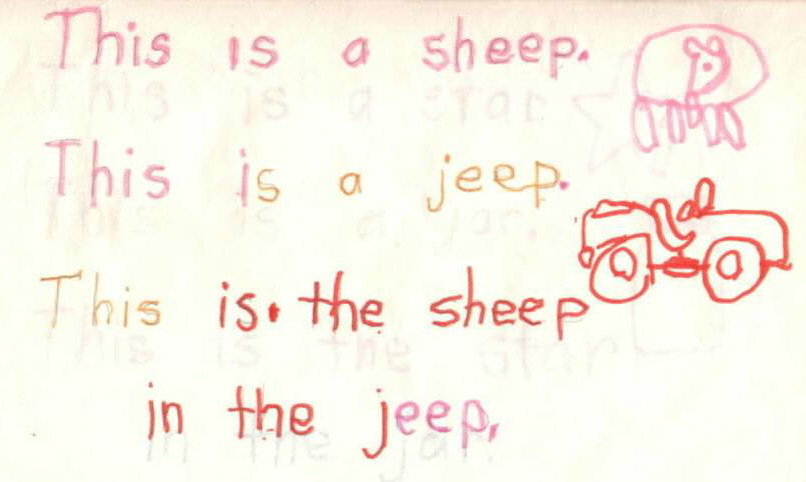 family members to express feelings and work out problems. family members to express feelings and work out problems.
Use patterns from predictable books to inspire original works. For example, after reading The Bug in the Jug, my then five-year-old daughter wrote and illustrated
a book. It reads:
“This is a sheep. This is a jeep. This is the sheep in the jeep.
This is a star. This is a jar. This is the star in the jar.
This is a whale. This is a pail. This is the whale in the pail.”
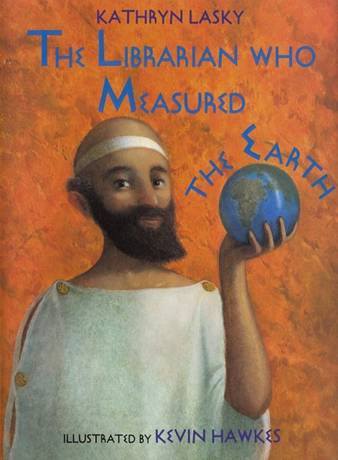 I -- Use Real Books for Your Reading Program. I -- Use Real Books for Your Reading Program.
Library books, inexpensive paperbacks, non-fiction books, and magazines are much more interesting than basal readers. Avoid reading workbooks (typically students complete three to six workbook pages for each story they read) unless you want to instill an aversion to reading. I heard Jim Trelease, author of The New Read-Aloud Handbook, say that many Americans are alliterate (able to read but choose not to) because of the thousands of senseless workbook pages associated with reading that they were forced to do in school. Strive for a book-centered approach to reading.
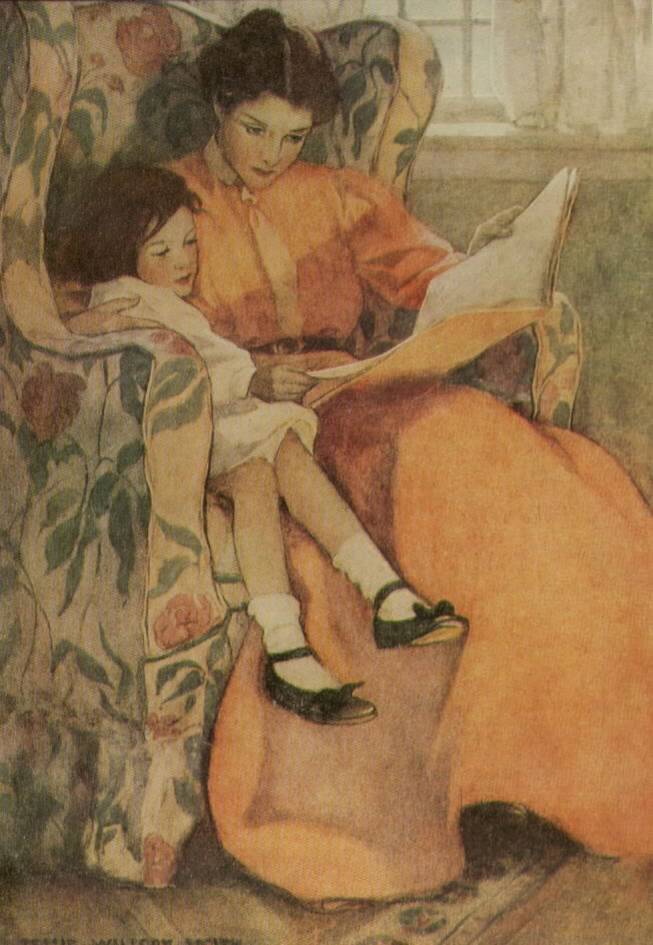 J -- Relax and enjoy! J -- Relax and enjoy!
Keep things low-keyed. Avoid putting pressure on your child to read at a certain age. Don't try to dictate what he may read; we all like to choose our own reading material. If your child reads every book in a particular series, at least he's reading. You can expand horizons through your read-aloud program. Does testing for comprehension really have a place in the home when we can hear our children laugh (or cry) as they read? Discuss books with children informally or have them narrate the story line instead of requiring book reports.
Watching our own children learn how to read is a memorable event. Because of our decision to educate our children at home, we are present to experience that light turning on. We see things starting to click. How thrilling to observe a tentative reader turn into an avid one! Let's soar with our children into the fascinating world of reading.
|